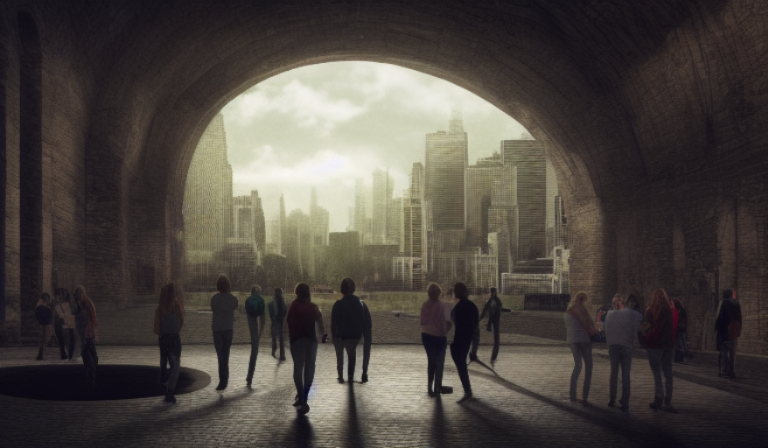Digital creations
From math based applications to the most recent AI powered tools, I am passionate about computer graphics.

Playing with computer graphics
I am not good at drawing by hand, but I am fond of all the applications that allow you to create images through some generative process. In the early Nineties the 2D fractals were a hot topic thanks to programs for the IBM PC and compatibles like FractINT, then raytraced images became the next big thing thanks to a free application called POV-Ray. You did not create a model through a visual interface and you had to learn its language to describe the scene to render. The images were stunning, but the modeling was a real challenge. The time required to generate a single image of a fractal or a raytracing was in the range of tens of minutes if not hours and every result was either a total delusion or worth framing and hanging on the wall. All the experiments I made let me acquire some sensitivity and skills with these branches of computer graphics.
From CPU to GPU
Information Technology has so far kept its promises of evolution and Moore’s law is still working, even if many times its demise was announced. The needs for power in the office environment are satisfied since years and the main reason graphics and processing are still pushed is the Gaming Industry, an industry that has numbers way bigger than you may expect. In 2021 this industry was bigger than movie and music industry combined, with over 180 billion dollars of turnover.
Applications like 3D modeling, generative design, Artificial Intelligence are currently considered niches – compared to gaming – that benefit from the Graphics Card architectures and their GPU.
Fractals can be now made in 3D and at amazing resolution, while the processing power allows photogrammetry on a notebook, starting from a series of pictures taken with the smartphone and ending with a 3D model.
3D animations can be now previewed, simplified, in real time even on a modest machine equipped with a basic GPU.











Artificial Intelligence, with its many branches, is now entering new areas that were formerly thought to be a human exclusivity. AI can translate texts with an “understanding” of the topic and the proper rephrasing. Music can be generated from existing compositions or specifying a genre and some styles. Images can be created in many ways.
From lab to desktop
2022 will be remembered for many reasons and from my point of view one is the availability of a complete AI solution to generate images as open source, downloadable and installable on a local machine. Some image generators are available through web interfaces and websites, but each has limits or constraints. There soon will be a market for such services and if your skills with IT are limited, that will be your best option.
For me, spending time on Github – a service where the Open Source thrives and is shared -, reading pages and pages of documentation, going to a CLI interface to issue commands and accept failed installations and errors is part of the fun. Every issue is an opportunity to learn something new and may past experience as software reviewer for PC World taught me that patience is the secret ingredient for a successful installation.
When the Stable Diffusion AI generator was made available in August, some developers started to work to turn it into something that could run locally: no queues, no limitations on the resolution, more control and fine tuning of the parameters and total creative freedom.
I have my local installation and I have ben practicing on it since the beginning of September 2022; it is addictive, it is amazing, it is awesome. I am available to share with you my findings, guiding you and your creativity in this new space. I am just scratching the surface of this technology and I am no expert, nevertheless I would like to share with you some themed series of images to give you a glimpse of what you can achieve.
Dubai seen by AI







Fashion sketches






Future city landscape
![00457-1766412747-image of a futuristic place with some ((people)), photorealistic, [buildings], ((flying cars)), some vegetation, clear sky, clou](https://wemakeyour.art/wp-content/uploads/2022/09/00457-1766412747-image-of-a-futuristic-place-with-some-people-photorealistic-buildings-flying-cars-some-vegetation-clear-sky-clou-768x480.png)
![00463-1766412753-image of a futuristic place with some ((people)), photorealistic, [buildings], ((flying cars)), some vegetation, clear sky, clou](https://wemakeyour.art/wp-content/uploads/2022/09/00463-1766412753-image-of-a-futuristic-place-with-some-people-photorealistic-buildings-flying-cars-some-vegetation-clear-sky-clou-768x480.png)
![00465-1766412755-image of a futuristic place with some ((people)), photorealistic, [buildings], ((flying cars)), some vegetation, clear sky, clou](https://wemakeyour.art/wp-content/uploads/2022/09/00465-1766412755-image-of-a-futuristic-place-with-some-people-photorealistic-buildings-flying-cars-some-vegetation-clear-sky-clou-768x480.png)
![00469-1766412759-image of a futuristic place with some ((people)), photorealistic, [buildings], ((flying cars)), some vegetation, clear sky, clou](https://wemakeyour.art/wp-content/uploads/2022/09/00469-1766412759-image-of-a-futuristic-place-with-some-people-photorealistic-buildings-flying-cars-some-vegetation-clear-sky-clou-768x480.png)
![00471-1766412761-image of a futuristic place with some ((people)), photorealistic, [buildings], ((flying cars)), some vegetation, clear sky, clou](https://wemakeyour.art/wp-content/uploads/2022/09/00471-1766412761-image-of-a-futuristic-place-with-some-people-photorealistic-buildings-flying-cars-some-vegetation-clear-sky-clou-768x480.png)
Art Gallery









Going technical









Painted landscapes






Virtual architects

















